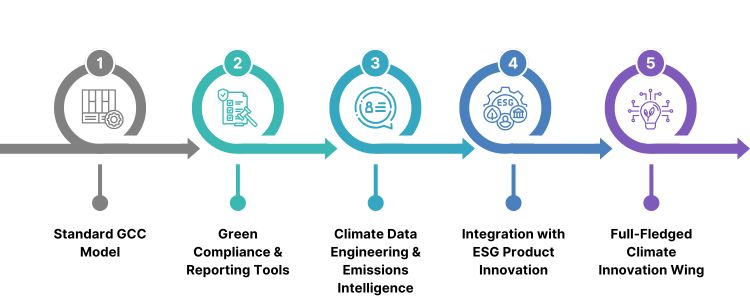
It is 2030. One of the renowned FMCG brands in Europe has been subject to legal and regulatory reprisal due to its inability to disclose carbon emissions. What was thereason of the failure ? An India-Based Global Capability Centre (GCC) Responsible for Emission-Related Compliance Reporting. As carbon regulations tighten across the EU, US, and APAC, the Multinational Corporations are being held accountable for their offshore footprints. India’s rapidly evolving digital infrastructure, climate-conscious policymaking, and maturing innovation ecosystem offer the ideal environment for transformation. The time has come for every GCC to Evolve into a Climate-Smart Innovation Center.
GCCs, Once Peripheral to ESG Mandates, are now integral to them. With over 90% of Fortune 1000 Companies Publishing ESG Disclosures, Scope 3 Emissions – that Include Offshore Operations, Under Intense Scrutiny. Regulatory frameworks such as the EU’s Corporate Sustainability Reporting Directive (CSRD) and the U.S. Sec’s Climate disclosure Rule Are Pushing Enterprises to Look Deeper Into Their Extended Enterprise Models. India-Based GCCs must respond with compliance as well as with innovation.
India’s Digital and Tech Infrastructure, Combined with the Rising Green Economy, Creates Fortile Ground for Innovation-LED SG Transformation. Forward-Looking GCCs are already moving beyond carbon calculators to embed sustainability in digital products, supply chains, and business models. India is home to over 350 climate-tech startups, and the nation has pledged to reduce emissions intensity by 45% by 2030. Additionally, India’s Emerging Carbon Credit Ecosystem – Valued at an Estimated $1.5 Billion by 2027 and this offers Gccs as an opportunity to contribute and benefit from Verified Emission Initiation.
Below is a functional blueprint every future-focused gcc can adopt: Climate Innovation Wing Blueprint
India provides specific economic and talent benefits that prepare its GCC ecosystem for global climate innovation: It brings the Indian GCC into a position to provide high-influence innovation at a globally competitive cost.
As the environmental challenges are increasing, GCC can no longer remain inactive service providers. Climate leadership is emerging as a major differentiator for the GCC in the future. By incorporating dedicated climate innovation branches, GCC can not only prepare its original enterprises for the future but can also increase India’s global leadership in climate technology, sustainability engineering and ethical delivery.
Now is the time to take action—not only for compliance, but also for change. For the co-construction of climate-oriented offshore development centers in India, partnership with Inductus GCC. Our custom-made innovations provide speed and scale to pod carbon intelligence, green engineering and ESG-esophaged value. Turn your GCC into a global stability center.
GCC Scope 3 is accountable for emissions under Global ESG rules. Climate innovation not only ensures compliance but also adds strategic value through green changes and product-level stability. The Climate innovation wing is a dedicated task that creates a carbon data system, a green DevOps framework, and climate-risk analysis and collaborates with climate-technical startups to create low-carbon solutions. These use AI/ML for GCC emission forecasts, IOT for real-time energy tracking, blockchain for ESG reporting transparency, and digital twins for climate risk modelling. Yes. All the corporates having GCC can invest in the renewable energy generation, energy efficiency, and forest plantation programmes and they will receive tradable carbon credits contained in the carbon trading system present in India. Climate-fed GCCs reduce long-term compliance costs, promote stability-related investment, and increase brand equity—especially between ESG-conscious customers and investors. Aditi, with a strong background in forensic science and biotechnology, brings an innovative scientific perspective to her work. Her expertise spans research, analytics, and strategic advisory in consulting and GCC environments. She has published numerous research papers and articles. A versatile writer in both technical and creative domains, Aditi excels at translating complex subjects into compelling insights. Which she aligns seamlessly with consulting, advisory domain, and GCC operations. Her ability to bridge science, business, and storytelling positions her as a strategic thinker who can drive data-informed decision-making.
GCCs in The Climate Crosshairs
GCCS as Climate Innovation Hubs
What a Climate Innovation Wing Should Look Like
Function
Description
Engineering of Climatic Information
Develop current time carbon accounting structures, monitor Scope 1-3 emissions, and automate sustainability metrics to meet compliance and insight.
Sustainable DevOps
Maximise the energy efficiency of cloud and on-premise systems, use lower carbon footprint structures, and encourage the development of green software engineering.
ESG Startup Lab
Support cross-collaboration with Indian climate-tech innovators to pilot and expand new solutions against net-zero ambitions.
Climate Risk Intelligence
Build digital twins and forecasting models on climate scenario planning, extreme weather forecasts and business continuity.
Low-Carbon Product Design
Incorporate climate-resilient thoughts into the product lifecycle, i.e. concept to coding, with eco-efficiency and legislative compatibility embedded.
Renewable Integration Office
The actions would include enabling GCC operations in renewable-powered facilities with the monitoring of the grid effect and enabling internal decarbonisation goals.
Circular Tech Initiatives
Design and pilot zero-waste technology stacks, optimise hardware recycling programmes, and enable circular digital infrastructure.
Why India is leading the Climate Technology Equation

Ready for the Future
Conclusion
frequently asked questions (FAQs)

Aditi
Hey, like this? Why not share it with a buddy?
Related Posts
Recent Blog / Post
- Agile Methodologies for GCCs: A Blueprint for Success October 6, 2025
- The Legal and Compliance Checklist for a New GCC Setup October 4, 2025
- The Rise of Niche GCCs: A Focus on Specialised Capabilities October 4, 2025
- The Impact of Regulatory Changes on GCC Operations October 4, 2025
- Cybersecurity for GCCs: A Proactive Approach to Data Protection September 30, 2025
- Beyond Cost: Measuring the True ROI of Your GCC Investment September 29, 2025
- The Future of GCCs in the Retail Sector: A Strategic Playbook September 29, 2025
- David vs Goliath: Mid-Sized GCCs Quietly Outperform the Big Brands September 29, 2025
- Infineon’s Big Bet on India: Inside Its First GCC in GIFT City September 29, 2025
- From Campuses to Capability Centres: How Indian Universities Power the Global GCC Ecosystem September 29, 2025
- Retail Meets Digital: Costco’s GCC in Hyderabad Marks a Global Shift September 29, 2025
- The Silent Crisis: Why Many GCCs Plateau After 3 Years and How to Avoid It September 24, 2025
- Germany’s New Skilled Immigration Act and Its Ripple Effect on the GCC Talent Model September 24, 2025
- From Tokyo to Hyderabad: The Future of GCCs for Japanese Conglomerates September 23, 2025
- GCCs as AI Acceleration Hubs: Collaborating with US and Nordic Tech Majors September 19, 2025
















